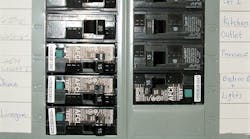All references are based on the 2014 edition of the NEC.
I may catch some flak for this one, but I’m going to stick my neck out and boldly state that AFCI protection is not required when modifications or extensions are made to an existing 120V, single-phase 15A or 20A branch circuit in a dwelling unit bedroom. This may seem to contradict the requirements of Sec. 210.12(B). However, in my interpretation, it would depend upon exactly where those extensions or modifications are made.
The literally wording in Sec. 210.12(B) of the 2014 NEC requires AFCI protection for branch circuit modifications, replacements, or extensions “in” any of the areas outlined in Sec. 210.12(A). Although bedrooms are one of the areas specified in this section of the Code, what if the modifications or extensions to the bedroom circuit are not made “in” the bedroom? What if they’re made “in” the unfinished basement?
For example, what if I rerouted and extended some wiring supplying the bedroom 20 ft because a wooden beam in the basement was being replaced due to termite damage? What if I even added a basement receptacle to that same bedroom circuit while I was at it? The Exception to Sec. 210.12(B) says that AFCI protection “is not” required only when the extension is not more than 6 ft and does not contain any additional outlets or devices. I contend, however, that since all of this work was done “in” the basement, and not “in” the bedroom, the literal wording in Sec. 210.12(B) “does not” require AFCI protection to be provided for that branch circuit. We could argue the same point for extensions or modifications made in garages or attics too, since those areas are not specified in Sec. 210.12(A) either.
Is this the intent of the wording? It may be best to check with your local Authority Having Jurisdiction (AHJ) for interpretation on this one.
If the wording in the Code were slightly different, perhaps my interpretation would be different. For example, instead of stating “In any of the areas specified in 210.12(A)…” if Sec. 210.12(B) stated “For branch circuits supplying any of the areas in 210.12(A)…” then I would say that those wires that were extended in the basement would require AFCI protection because that branch circuit “supplied” the bedroom. Of course, providing AFCI protection is a great way to provide an extra level of safety and better protection for your customer and their family members.





